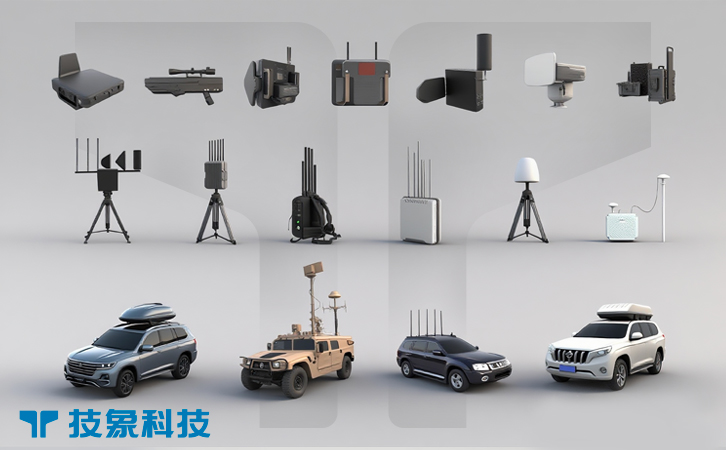The increasing accessibility of unmanned aerial vehicles (UAVs) has heightened the need for flexible and rapidly deployable anti-UAV defense systems to counter threats in dynamic environments. Portable anti-UAV solutions, such as handheld jammers, net-launchers, and mobile detection units, offer agile responses for temporary or mobile security needs, such as protecting public events, VIPs, or remote operations. Unlike fixed systems designed for permanent installations, portable solutions prioritize mobility, ease of use, and rapid setup, making them ideal for scenarios where threats are unpredictable or infrastructure is limited. This article explores the design, applications, operational advantages, and future innovations of portable anti-UAV systems, highlighting their critical role in addressing dynamic security challenges.
I. Design and Functionality of Portable Anti-UAV Systems
Portable anti-UAV systems are engineered for mobility, compactness, and ease of deployment, enabling security teams to respond to drone threats in diverse settings. These systems typically include handheld or vehicle-mounted devices, such as RF jammers, laser-based neutralizers, or net-launchers, designed to be lightweight and user-friendly. For example, the DroneDefender, a handheld RF jammer, weighs approximately 4 kilograms and can disrupt drone control signals up to 400 meters away, forcing UAVs to land or return to their operators. Similarly, net-launching devices like the SkyWall 100 use compressed gas to fire nets that capture drones without destroying them, preserving evidence for analysis.
The functionality of these systems revolves around a detect-and-neutralize framework. Detection is often achieved through compact radar or RF sensors integrated into the device or carried separately, capable of identifying drones within a 1-2 kilometer range. Some systems, like the DroneHunter, combine detection and interception by deploying a counter-drone that captures rogue UAVs with a net. Power efficiency is critical, with many devices using rechargeable batteries or portable generators to support extended field operations. User interfaces, often in the form of simple trigger mechanisms or smartphone apps, allow non-specialized personnel to operate these systems with minimal training. The design emphasizes rapid setup—often under a minute—ensuring immediate response to emerging threats in dynamic environments.
II. Applications in Temporary and Mobile Security Scenarios
Portable anti-UAV systems are tailored for scenarios requiring temporary or mobile security, where fixed installations are impractical. Public events, such as concerts, sports tournaments, or political rallies, are prime applications. For instance, during the 2020 Tokyo Olympics, portable jammers and net-launchers were deployed to secure stadiums against unauthorized drones, ensuring spectator safety and preventing disruptions. These systems are ideal for such settings due to their quick deployment and ability to cover specific zones, such as a stadium’s airspace, without interfering with broader communications.
Other applications include VIP protection and law enforcement operations. High-profile individuals, such as celebrities or government officials, use portable anti-UAV systems to prevent drone-based surveillance or attacks on private estates or during travel. Law enforcement agencies deploy these systems during high-risk operations, such as counter-terrorism missions or border patrols, where drones may be used for smuggling or reconnaissance. For example, U.S. Customs and Border Protection uses portable RF jammers to intercept drones smuggling contraband across borders. In disaster response scenarios, portable systems protect temporary command centers or refugee camps from drone intrusions, ensuring operational security. The versatility of these systems makes them indispensable for addressing short-term, high-stakes security needs across civilian and tactical contexts.
III. Operational Advantages of Portable Systems
The primary advantage of portable anti-UAV systems is their flexibility, enabling rapid deployment in environments where fixed systems are infeasible. Unlike stationary radar arrays or high-powered laser installations, portable devices can be carried by a single operator or mounted on vehicles, allowing security teams to respond to threats in real time. For instance, a handheld jammer can be activated within seconds to neutralize a drone spotted during a public event, minimizing response time compared to coordinating with a fixed command center.
Cost-effectiveness is another key benefit. Portable systems are generally less expensive than comprehensive fixed installations, making them accessible to smaller organizations, event organizers, or developing nations. Their modular design allows for scalability; additional units can be deployed to cover larger areas or counter multiple drones. Non-kinetic countermeasures, such as RF jamming or net-capture, reduce the risk of collateral damage, making them suitable for urban or crowded settings. For example, a net-launcher can safely disable a drone over a festival without endangering attendees. Additionally, these systems require minimal infrastructure, relying on battery power or portable generators, which is ideal for remote locations or areas with limited electrical access. The ease of use, with intuitive controls and minimal training requirements, empowers security personnel to focus on threat response rather than complex system management.
IV. Challenges and Future Innovations
Despite their advantages, portable anti-UAV systems face several challenges. Limited range is a significant constraint; handheld jammers or radars typically operate within a 1-2 kilometer radius, making them less effective against high-altitude or long-range drones. Battery life is another limitation, as extended operations may require frequent recharging or backup power sources. In urban environments, signal interference from Wi-Fi networks or other electronic devices can reduce the effectiveness of RF-based detection and jamming, necessitating advanced signal filtering. Countering drone swarms is also challenging, as portable systems are typically designed for single-target engagement, requiring multiple units or specialized countermeasures for swarm scenarios.
Future innovations are poised to address these challenges. Advances in miniaturization will enable more powerful sensors and countermeasures in smaller, lighter packages, extending range and battery life. For instance, next-generation RF jammers may incorporate AI to dynamically adjust frequencies, avoiding interference with legitimate communications. Integration with 5G networks will enhance real-time data sharing, allowing portable systems to coordinate with larger defense networks for comprehensive coverage. Emerging technologies, such as compact high-powered microwave (HPM) devices, could enable portable systems to neutralize multiple drones simultaneously, addressing swarm threats. Additionally, solar-powered or kinetic-energy harvesting systems will improve sustainability, supporting longer deployments in remote areas. These innovations will make portable anti-UAV systems more versatile, reliable, and capable of meeting the evolving demands of dynamic security environments.
Conclusion
Portable anti-UAV solutions are critical for addressing dynamic security needs, offering mobility, rapid deployment, and cost-effective defense against drone threats. Their compact design and versatile applications—from securing public events to protecting VIPs and supporting law enforcement—make them invaluable in scenarios where fixed systems are impractical. While challenges like limited range and battery life persist, ongoing advancements in AI, connectivity, and countermeasure technologies promise to enhance their capabilities. As drone threats continue to evolve, portable anti-UAV systems will play an increasingly vital role in ensuring airspace security, providing agile and effective solutions for a wide range of operational contexts.



